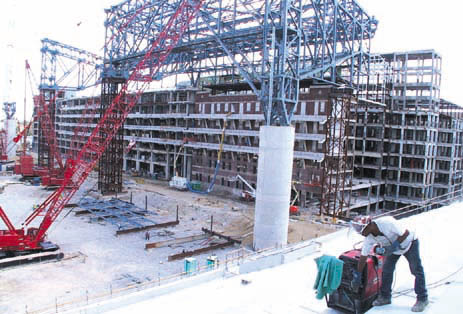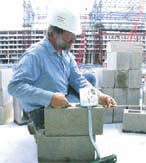Trades get ready for Ford Field blitz
Date Posted: July 20 2001
More than 600 Hardhats are currently in the Ford Field playbook, working to shape the future gridiron into one of the most unique stadiums in the nation. In two months, the roster of trades workers is expected to double - making the football stadium project in Detroit among the largest construction jobs in the state.
Ford Field is actually two projects being handled simultaneously. One is the renovation of the 80-year-old Hudson's warehouse, which will form the south wall of the stadium and will house luxury suites, press box, restaurants, food courts, lounge areas, banquet facilities and retail and office space. That portion of the project is being managed by White/Olson. Calling the plays for the rest of the stadium job outside of the warehouse are Hunt Construction Group and Jenkins Construction.Ground was broken on the project on Nov. 16, 1999, and the entire project is set for completion on July 1, 2002. The stadium will seat 65,000 and will cost more than $300 million.
Tom Lewand, the Lions' vice president for stadium development, earlier this year talked about a number of features of the new stadium. The priority listed here is in the eye of the beholder:
- The facility will be constructed in a style that exposes many of the construction materials, from the massive steel supporting the roof, to the ductwork and piping in the concourses, to the glass atrium that will enclose a street behind the stadium.
- Virtually all the seats will have drink holders.
- Lewand said the technology for the use of natural grass indoors "simply is not practical right now." so the gridiron will likely be made up of new high-tech articifical "FieldTurf" that was introduced in Seattle's Enron Field.
- The field will be large enough to accommodate soccer games.
- The 65,000-seat capacity - 15,000 below the Pontiac Silverdome's - was arrived at, Lewand said, because the Lions "collectively decided on a figure that could be large enough to accommodate our fans and sell out every game to eliminate (television) blackouts."
- The Lions opted not to spend an additional $60 million for a retractable roof.
- It should go without saying, but Lewand promised no obstructed view seats, and added, "As a matter of fact, Ford Field will have the best sight-lines in the NFL. The highest seat in our stadium is roughly equivalent to the first few rows in the upper decks of new stadiums in Tampa, Cleveland, Baltimore, and others." Tiger Stadium's posts are still fresh in the minds of some fans.
- The old 750,000-square-foot Hudson's Warehouse will house nearly all of the stadium luxury seats, a press box, restaurants, food courts, lounge areas, banquet facilities and retail and office space. Rather than sitting in a sterile indoor environment fans will have a view of the city skyline with natural light shining through the glass wall at the main entrance of Adams and Brush.
The unconventional stadium is also being constructed unconventionally. The stadium's upper bowl is rising first, followed by the roof. The lower bowl will be dug out after most of the buildings exterior is complete in order to make it easier to build the rest of the structure. For the sake of worker safety, steel trusses that will support the roof are being constructed on the field and are being lifted into place.
Ford Field will be the home to Super Bowl XL on Feb. 5, 2006.
"You are not going to see another one of these or anything even close to it any place," said Michael McGunn, project manager for SmithGroup, the lead design and engineering team. "The connection to a warehouse hasn't been done in football. Even in baseball, the warehouse in Baltimore at Camden Yards is across the street. At this stadium, when you are in the warehouse, you are in the stadium."

BY THIS TIME NEXT year, about 120 luxury suites will fill what is now the shell of the old Hudson's Warehouse in Detroit, which is being incorparated into the design of Ford Field. Working on what will be the seats in the western end zone is Marvin Anderson of Iron Workers Local 25, who is setting up a generator to power a grinder.

BRICKLAYER apprentice Andrew Engel of Local 1 sets up block around an electrical box at Ford Field.
